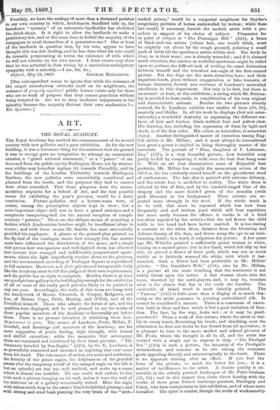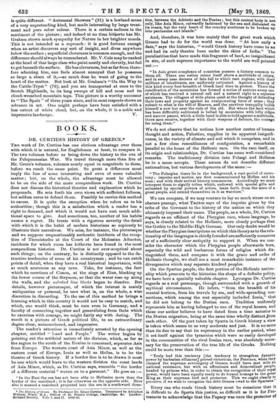ART.
--4■-•-••••
THE ROYAL ACADEMY.
THE Royal Academy has marked the commencement of its second century with new galleries and a poor exhibition. As for the new
building, it was a fortunate thing for the architect that the ground it was to occupy gave no temptation to attempt an ornamental exterior, a "grand national monument," or a " palace " of art. Screened from the public eye by Burlington House (or by whatso ever edifice may hereafter replace it) towards Piccadilly, and by the buildings of the London University towards Burlington Gardens, the new galleries were unavoidably considered and planned from the inside, and the purposes they had to answer
were alone consulted. That these purposes were the accommodation requisite for a School of Art, and the best possible
rooms for exhibiting the year's pictures, would be a hasty
conclusion. Picture-galleries and a lecture-room were, of course, among the prescriptive objects kept in view ; but a more important object still was to have a grand entrance and a sumptuous banqueting-hall for the annual reception of complimentary "patrons." These are the oblique means of acquiring a fashion which Academician brushes might be insufficient alone to secure ; and with these means Mr. Smirks has moat successfully provided his employers. A glance at the ground-plan printed on the fly-leaf of the catalogue shows how strongly this last motive must have influenced the distribution of the space, and a single visit proves how one spacious and well-lighted room has elbowed into corners four cramped and indifferently-proportioned apartments, where the light imperfectly reaches down to the pictures, and the inconvenient crowding of Trafalgar Square is reproduced in full measure. However, a de facto private and irresponsible body like the Academy must be left free judges of their own requirements, and the public has no right to complain. Besides, there is at least one good picture-gallery in the building big enough for the exhibition of all or most of the really good pictures likely to be painted in any one year. Accordingly, the walls of this room are hung with the handywork of Messrs. Creswick, S. Cooper, Redgrave, and Lee, of Messrs. Cope, Frith, Horsley, and O'Neil, and of the President himself. Those who admire the forms of art, and the qualities here displayed, will be well pleased to see the works of those popular members of the Academy so favourably set before them. There is no present intention of criticizing them here. Requiescant in pace. The names of Landseer, Poole, Millais, F. Goodall, and Armitage (all members of the Academy) are far more suggestive of poetic feeling, high thought, with honest and skilful execution ; while the memories that accompany them are sustained and reinforced by their latest pictures. " The Swannery invaded by Sea-Eagles" (120), by Sir E. Landseer, is as powerfully conceived and executed as anything that ever came from his band. The vehemence of action, the noise and confusion, the ferocity of the pirate eagles, the helplessness of the graceful swans (for the temporary rebuff of the enraged eagle on the left is but an episode) are but too well realized, and make up a scene which is almost too horrible. No one could well endure to live with such a picture hanging on his wall, unless it were the wall of his staircase or of a gallery occasionally visited. Here the eagle with talons stuck deep in the swan's blood-bedabbled plumage, and with strong and cruel beak piercing the very brain of the "arch necked prince," would be a congenial neighbour for Snyder's sanguinary pictures of horses embowelled by wolves ; while these last would, if necessary, furnish the modern artist with a precedent in support of his choice of subject. Pleasanter far in point of subject is " The Ptarmigan Hill " (224), a brace of black-and-tan setters (whose feet, one would think, must be mightily cut about by the rough ground), pointing a small pack of birds till the sportsmen arrive within shot. The birds lie close, as is their wont ; one is already wounded ; and if it claimed much attention, the careless or unskilful sportsman might be called upon to perform the difficult task of settling the exact distinction between himself and the truculent sea-eagle of the first-named picture. But the dogs are the main attraction here ; and their sagacious heads, given without exaggeration or false travestie of human character, furnish new evidence of Landseer's unrivalled excellence in this department. Not only is he first, but there la no second : at least, at this exhibition ; a saving which Mr. Bottomley is entitled to have made, in consideration of his very original and characteristic animals. Besides the two pictures already noticed, Sir E. Landseer exhibits two studies of lions (30, 32), masterly and lifelike. In all his work he displays (but not ostentatiously) a wonderful dexterity in expressing the different surfaces of hair and feather, black-webbed foot and yellow claw. His drawing, too, including the expression of form by light and shade, is of the first order. His colour, as heretofore, is somewhat clayey. Another distinguished master of execution among English artists is Mr. Millais ; and it must always be remembered bow great a power is implied in being thoroughly master of his materials. The portrait of " Nina, daughter of F. Lehmann, Esq." (127), is a very beautiful picture, how beautiful may partly be felt by comparing it with oven the best that hang near it. With an art that characterizes some of Reynolds' beat portraits, Mr. Millais has caught the momentary action of the child as she has carelessly seated herself on the greenhouse stool of earthenware. The fair skin is painted with extreme delicacy, and the whole face is modelled to reality. The white dress is relieved by bits of blue, and by the emerald-tinged blue of the drapery and the more decided green of the camellia (with pink blossom) in the background. These colours are repeated more strongly in the stool. If the whole truth is to be told, that must be repeated which has now been frequently said and written (and which will bear repetition the more easily because the offence it marks is of a kind too often repeated by the artist)—that the red flower the child holds in her hand had been better omitted. It is too staring a contrast to the white dress, detracts from the blooming and delicate beauty of the face, and draws away the eye to an uninteresting detail ; in a word, it vulgarizes the picture. A few years ago Mr. Whistler painted a sufficiently gaunt woman in white, leaning on a mantel-piece ; but in her hand, which fell idly by her side, he placed a flower of faint pink, which was not so much visible as it furtively warmed the white, with which it harmonized. Such a flower had been preferable in Mr. Millais' picture. " The Gambler's Wife " (104), also by Mr. Millais, is a picture all the more touching that the sentiment is not rudely thrust upon the notice. A fair woman steals into the room, deserted by the card-players, and, it may be, wonders what is the charm that lies in the cards she handles. The card-table of inlaid wood is most daintily painted. The " Vanessa " (357) is little more than a display of so much dexterity as the artist possesses in painting embroidered silk. It cannot be considered a success. There is a coarseness of execution both in dress and face which is but a poor imitation of freedom. The face, by the way, looks wet ; or it may be pearlpowdered ? From a work of this nature, where the artist is visible in every touch, flourishing his brush, and chuckling over the admiration he does not doubt he has forced from all spectators, it is pleasant to turn to the more modest and refined pictures of Mr. Poole, where the thought is all in all, and the artist has worked with a single eye to express it duly. " The Prodigal Son" (140) is such a picture, the intensity of the Prodigal's wretchedness and remorse as he sits among the insensate goats appealing directly and uninterruptedly to the heart. There is no apparent striving after an effect. If you feel the force of the picture, so much the better for you ; it is a matter of indifference to the artist. A similar quality is observable in the soberly painted landscapes of Mr. Peter Graham (31, 76) ; and in this respect they claim direct kinship with the works of those great French landscape-painters, Daubigny and Corot, who have sent pictures to this exhibition, and of whom more hereafter. The spirit is similar, though the mode of workmanship
is quite different. " Autumnal Showers " (31) is a lowland scene of a very unpretending kind, but made interesting by large treatment and pure sober colour. There is a certain sadness in the sentiment of the picture ; and indeed at no time hitherto has Mr. Graham shown much sympathy for Nature in her brighter moods. This is not intended as a reproach : it is good fortune enough when an artist discovers any sort of insight, and dives anywhere below the surface ; superficial cleverness is common enough, and the difference should always be remembered. Mr. V. Cole maybe ranked at the head of that large class who paint neatly and cleverly, but fail to get beneath the surface. He has cleverness, but so far from therefore admiring him, one feels almost annoyed that he possesses so large a share of it,—so much does he want of going to the heart of the matter. But look at Mr. Graham's " On the Way to the Cattle-Tryst" (76), and you are transported at once to the Scotch Highlands, to its long sweeps of hill and moss and its cloud-wreathed mountain tops. This picture is a worthy successor to "The Spate " of three years since, and in most respects shows an advance in art. One might perhaps have been satisfied with a less extent of white cloud, but, on the whole, it is a noble and impressive landscape. V.































 Previous page
Previous page